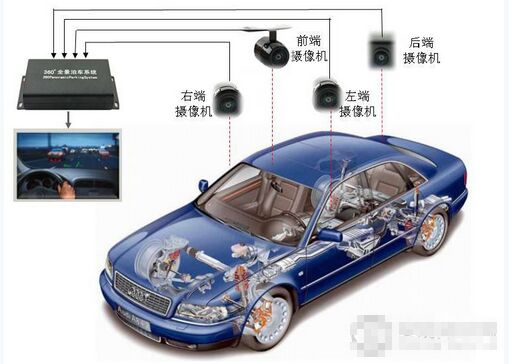
Car video surveillance has become an important application area covered by digital video surveillance technology. Due to various considerations such as car and driving safety, the video and vision systems involved must be stable and reliable, and the video transmission is more strict. Claim. The digitalization of video transmission has become an inevitable trend of development. Advanced Video Transfer (AVT), as a digital coaxial high-definition video transmission technology, fully supports the high-definition video equipment of vehicles with its superior image performance and outstanding system characteristics. Visual lossless and real-time transmission is beneficial for extending video recording to ADAS-related video applications. This paper first analyzes the technical characteristics of AVT technology in coaxial high-definition digitalization, and then introduces related system solutions and implementations in combination with practical applications, and finally looks forward to its prospects for improving the security of vehicle vision applications.
This article refers to the address: http://
The ideal of car vision shines into reality
After video surveillance began to spread, traffic became an important area for expanding applications in the industry. In addition to implementing video surveillance on the road, car video equipment is gradually installed inside the vehicle to collect video information and perform subsequent processing in time, which opens the era of vehicle monitoring. The early car video system was mainly a video recorder. Its purpose was to record the video images around the vehicle during driving. The camera was installed only in the front of the car, and the captured video was digitally compressed and stored. The delay is not too high. In order to expand the video surveillance range, a camera is added at the rear to increase the recording channel. Multiple channels of video can be processed separately or transmitted to the front-end processor for synthesis, and there is no special requirement for the means and quality of signal transmission.
With the advent of intelligent video processing technology, the video captured by the camera installed in the car can be analyzed and processed in real time, so as to provide early warning or warning to the situation that may occur in the driving, and the vehicle device has certain visual functions. This makes it possible to achieve an assisted driving effect. The car video system can be divided into two categories according to the application, one is a 360° panoramic video driving system, also known as a surround vision system; the other is a car rear view monitoring system. The system components and video transmission methods involved are described below.
As shown in Fig. 1, the 360° panoramic driving system is composed of a camera and a host computer in front and rear of the car. Each of the four cameras uses a fisheye lens to capture a wide-angle image and send it to the host to image. Splicing, trimming, etc., to generate a 360° panoramic picture, and then output to the LCD display. At present, the mainstream 360° panoramic products on the market mainly rely on standard definition solutions. The main reason is that when the pixels are low, the main processor capability of the panoramic host solution is not high. As more and more host chips provide vendor intervention, processor performance is growing, from dual-core to quad-core, and even to eight-core.
Therefore, the problem of processor power has basically been solved, and its performance is strong enough to support the load of HD video. Secondly, the 1280*600 resolution of the car screen was not high. With the popularity of the 720P HD resolution car-level display, the demand for HD monitoring of the car became more urgent. Each camera needs to be stable and reliable through the cable. High-definition video signals are transmitted to the host, so it is imperative to provide high-capacity and high-reliability digital high-definition video transmission.

Figure 1 360 ° panoramic driving system composition
The rear view monitoring system of the car is a big turning point in the form of the product on the driving recorder. From the previous product specification that meets the requirements of more users and users with different specifications and different configurations to meet the needs of more users. market. Before the popularization of the 360° panoramic driving system, the demand for the rear view monitoring system of the automobile was very high. It is reported that the monthly capacity of the market capacity has reached more than one million sets. Because the solution is cheap and the installation scheme is simple, only a small camera is needed at the license plate light. When the car starts to reverse, the screen automatically switches to the image of the reversing camera to achieve the function of assisting the owner to reverse, as shown in Figure 2. System block diagram for the program. Similarly, with the popularity of high-definition screens, more and more car owners are increasingly demanding high-definition cameras, so focusing on automotive rear-view applications, digital HD is also facing great opportunities.

Figure 2 Automotive rear view monitoring system
With the gradual increase of products, there are more main control chip manufacturers to participate in the competition, for example, Quanzhi mainly pushes T3 series and V series chips; MediaTek launches intelligent rear view video chip; Mercedes is the application of the core 1860 chip Representative solution providers; Rockchip and Intel jointly launched the codename Sofia3G-R will also be mass-produced; there are also players equipped with Qualcomm platform and other programs.
Innovative means of video transmission in the car
Digital high-definition video transmission technology has an extraordinary significance for improving the performance and quality of car video equipment. It is not only used to improve the image quality and clarity of car video sources, but also to provide visual lossless and real-time video transmission means. In the automotive market, there is a need for both front-loading and post-installation equipment, and we are looking forward to adopting more efficient and reliable innovations in high-definition video transmission.
Looking at the wiring inside the car is very complicated, and the reliability requirements are very high, and there is not much selectivity left for the video connection. Ordinary AV audio and video cables are obviously not suitable for use in the car, so you need to consider the choice of coaxial cable or Ethernet cable. For high-definition video transmission, coaxial high-definition transmission system is currently popular, and the analog coaxial high-definition transmission system is mainly applied to high-definition video surveillance cameras such as AHD, HD-TVI and HD-CVI, while the digital coaxial HD system is not AVT. It belongs.
HD-TVI, HD-CVI, and AHD are high-definition video transmission specifications based on coaxial cable. They are analog high-definition solutions, which are implemented by intra-frame frequency addition, except that the frequency of each frequency is different. The means of implementation are basically the same as the methods. The advantage of this implementation is that the solution cost is low, and the image quality can be improved to 12,000 megapixels compared with the standard definition effect, which is called analog high definition. However, because the image is increased by intra-frame frequency addition. The pixel points cause the intra-frame frequency to increase, and the resulting image color interference is difficult to avoid. Although the ISP processing can make up for the defects of some people's eyes, such programs are popular in the industrial monitoring market. However, for the automotive market, in addition to satisfying the human eye, the main chip platform needs to be collected. Video to do intelligent analysis and processing, to achieve machine vision effects, such as automatic parking technology and more assisted driving, and future unmanned technology need to accurately capture the video, to ensure that these videos accurately send and receive, you must achieve complete Digital transmission. If the analog signal mode is still used in the transmission process, the loss of the video or even the loss of the video in the complex application environment of the vehicle is greatly reduced, which leads to the significant reduction of the recognition capability of the main control chip for the HD video, and this is indeed The automation and security of the car video system is unacceptable.
KNB2-63 Miniature Circuit Breaker
KNB2-63 Mini Circuit breakers, also named as the air switch which have a short for arc extinguishing device. It is a switch role, and also is a automatic protection of low-voltage electrical distribution. Its role is equivalent to the combination of switch. Fuse. Thermal Relay and other electrical components. It mainly used for short circuit and overload protection. Generally, According to the poles, mini Circuit breaker can be divided into 1P , 1P+N , 2P, 3P and 4P.
KNB2-63 Miniature Circuit Breaker,Electronics Miniature Circuits Breaker,Automatic Miniature Circuit Breaker,Mini Circuit Breaker
Wenzhou Korlen Electric Appliances Co., Ltd. , https://www.zjaccontactor.com
